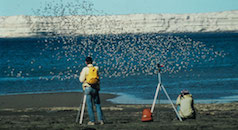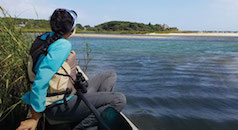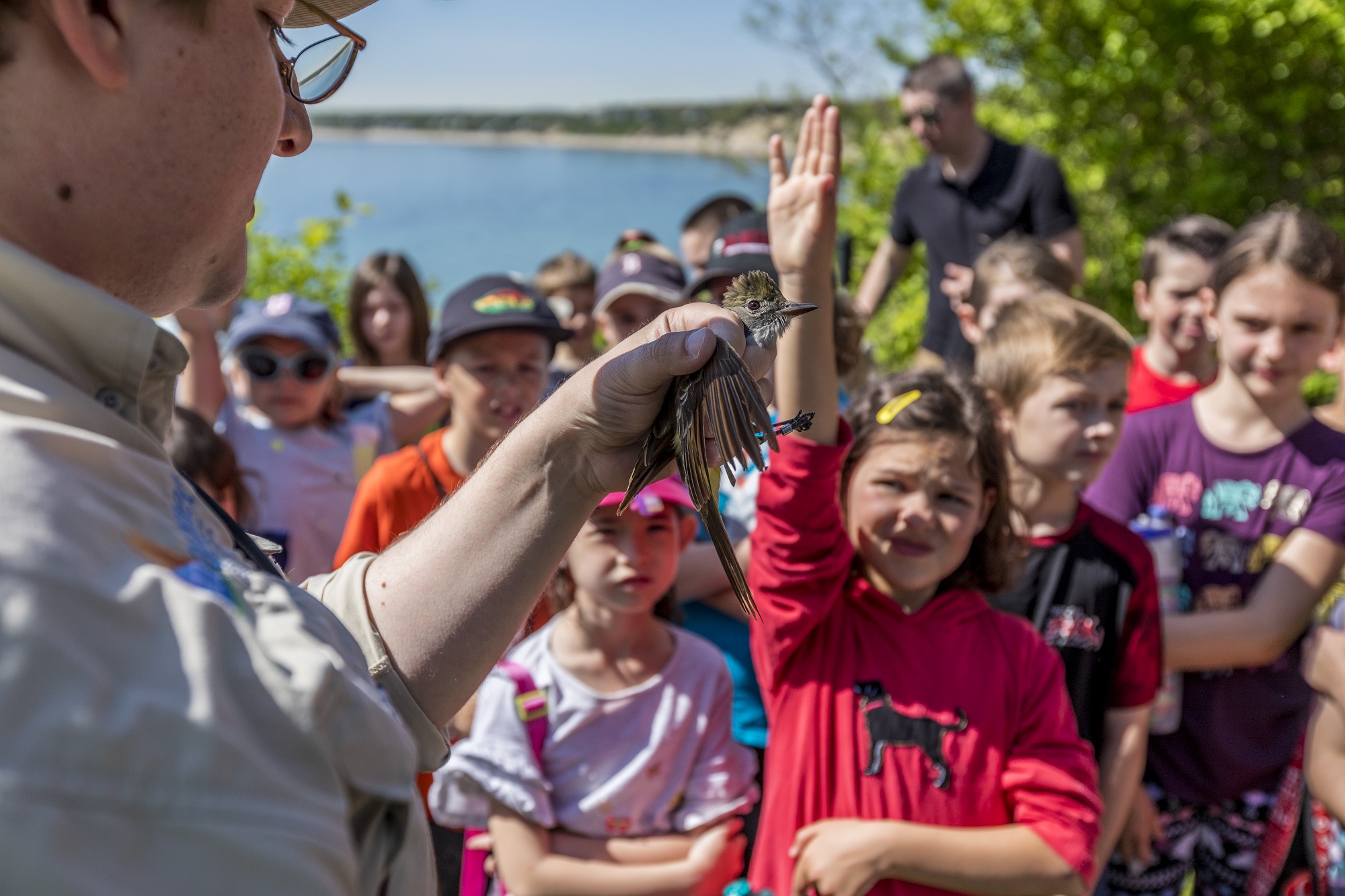Search Results

Arctic research team faces unprecedented conditions while monitoring shorebirds
Manomet scientists and collaborators are pressing through rough camp conditions to complete key research objectives. By Stephen Brown There is a famous saying based on the Thomas Wolfe novel of the same title: “you can’t go home again.” And if you do try, things will be very different than when you were there before. This year, we went back to the arctic, which feels like “home” to many of Manomet’s field biologists, and true to form things were very different! The arctic is immense, so studying anything at the landscape scale is a huge undertaking. In 2000, we helped develop the Program for Regional and International Shorebird Monitoring (PRISM). In 2002, we launched our first team expedition with U.S. Fish...
Manomet’s Arctic shorebird researchers return to Alaska
This season, the Manomet team and research partners are surveying shorebirds on the Arctic coastal plain and assessing shorebird nesting success. They are also testing new audio recording and machine learning technologies that could greatly expand shorebird monitoring capabilities in remote locations. By Stephen Brown Welcome to the 2022 field season edition of Manomet’s Shorebird Science Blog! We hope you enjoyed our first post about our exciting work underway in Texas with support from the Knobloch Family Foundation. The format of the blog is a bit different from previous years, as you can see; we will be posting a series of articles describing each project as they unfold in the field. This introductory post is just to let you know...
Central American coastlines take center stage in Atlantic shorebird conservation efforts
By Julia Salazar The Caribbean coastlines of Central America are poised to become the next key conservation priority for the Atlantic Flyway Shorebird Initiative (AFSI), an effort to contribute to the management and protection of shorebird habitat led by the US Fish and Wildlife Service (USFWS). As other stopover sites for birds migrating between the Arctic to South America decline due to human and climate-related impacts, Caribbean coastlines in Central America can provide alternative feeding and resting spots along these birds’ multi-continental journeys. This effort, which kicked off in February 2022, is led by Western Hemisphere Shorebird Reserve Network (WHSRN)'s executive office (housed within Manomet’s Flyways team) and is supported by an advisory committee of regional shorebird experts and the USFWS. By...
Whimbrels, wearing satellite transmitters, reveal links between Cape Cod and sites sprinkled across the Western Hemisphere
By Kat J. McAlpine For long-distance migratory shorebirds like the Whimbrel–which over the course of a year travel from breeding grounds in the Arctic to South America’s coastlines and then back again–Cape Cod’s salt marshes provide a welcome stopover on this extensive journey. During these stopovers, Whimbrels feast on the bounty of food that the Cape’s salt marshes offer, particularly fiddler crabs. As they gather in concentrated areas where nutrients are dense, spots along their journey that biologists call “staging sites,” Manomet researchers take the opportunity to fit some of the birds with devices that transmit their location data via satellites. Whimbrels, bigger and heavier than many other species of shorebirds, are the perfect “hiker” for these location trackers to...
Top 10 birds at Manomet’s headquarters
By Alan Kneidel In 2021, at Manomet’s 40-acre headquarters location in Plymouth, Massachusetts, a total of 209 bird species were cataloged in the eBird smartphone app by many different observers. Our contributing pool of observations came from birds caught in mist-nets on Manomet’s coastal property and then banded by scientists at Manomet Observatory’s bird banding lab, birds observed during our weekly property censuses for biodiversity, and other incidental observations. Manomet’s headquarters sprawl across a variety of habitats, including freshwater wetlands, a coastal forest, upland meadows, gardens, and an oceanfront bluff overlooking the Cape Cod Bay. In addition to its natural wealth, Manomet’s Plymouth campus is home to a rich history of ornithological observation and research, which dates back to early-1900s...
Support Arctic Research for Shorebird Conservation
During June 2019 fieldwork in the Arctic National Wildlife Refuge, Manomet scientists made an unexpected and exciting discovery: an unusually high concentration of Whimbrels nesting in the Katakturuk River Valley. These shorebirds are normally isolated and solitary nesters, so finding 14 to 16 of them clustering their nest sites in one area of this Arctic valley presents a unique opportunity for research—scientists have never before observed a tightly-packed nesting location of Whimbrels, indicating the significance of this particular location and group of birds. From satellite transmitters that Manomet scientists placed on some of these Whimbrels—super lightweight tracking devices worn like tiny backpacks by the birds—we received data indicating that birds migrating south from this nesting site made different decisions about...
Four new sites and one new country added to WHSRN
When evading a predator, there is safety in numbers. But for shorebirds, there is also danger in numbers. Many shorebird species gather in large numbers at just a few specific sites to rest and refuel during migration. Threats to habitat at any one of these critical staging areas could mean destroying a species’ whole flyway population. Shorebird populations have been reduced to a fraction of what they once were. To recover these species, it is essential to protect a network of these stopover sites, ensuring that shorebirds have a safe place to rest and feed on their long migrations. The Western Hemisphere Shorebird Reserve Network (WHSRN), founded in 1986, seeks to address the threats that face shorebirds with a site-based,...
Whimbrels in the Arctic
Shiloh Schulte, Manomet’s senior shorebird scientist, recently spent four weeks in the Arctic National Wildlife Refuge, continuing several studies delayed by COVID-19. Working closely with the U.S Fish and Wildlife Service, Shiloh deployed GPS tracking tags on Whimbrel, American Golden-Plovers, Pectoral Sandpipers, and other species as part of an ongoing study of local movement patterns and long-distance migration pathways and stopover sites. In addition to the tracking work, Shiloh collaborated to develop methods for remote monitoring of shorebird nests and mentored new USFWS technicians and volunteers. Shiloh recently shared his experiences on Alaska's Katakturuk River tagging Whimbrels to study local movement patterns and long-distance migration pathways and stopover sites. I have been lying flat in the sedge, hiding behind a...
Are invasive green crab populations in the Gulf of Maine rising?
The European green crab (Carcinus maenas) is a harmful invasive species linked to the decline of the soft-shell clam industry in New England and the degradation and loss of critical eelgrass and salt marsh habitat. Compounding these issues is the link between increasing green crab abundance and increasing ocean temperature, which has had severe ecological and socio-economic consequences in areas such as the Gulf of Maine, where warming is occurring faster than 99% of the world's oceans. In 2018, Manomet began our long-term intertidal crab monitoring project to track green crab population trends. We also collect data on native crabs and other invasive species such as the Asian shore crab. Our monitoring sites span much of mid-Coast Maine, from Damariscotta...
How is climate change impacting food availability for shorebirds?
One of the big questions we are addressing through our research is determining what threats limit shorebird populations. The work of the Arctic Shorebird Demographics Network (ASDN), which included 16 partner organizations, has substantially increased our ability to address a wide variety of science and conservation goals. We co-led the network of partners along with Rick Lanctot from the US Fish and Wildlife Service and Brett Sandercock from Kansas State University. Through this partnership and collaboration, the ASDN has examined species and topics at a very large scale (e.g., Russia to western Canada). The ASDN team has collected data on migratory connectivity, as well as adult survival, productivity, and other demographic parameters at various stages of a shorebird’s annual cycle....



